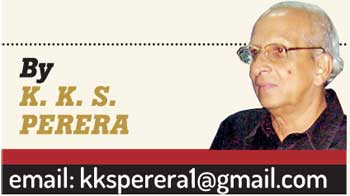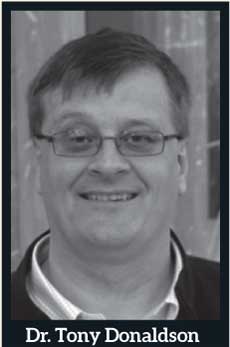Reply To:
Name - Reply Comment
Last Updated : 2024-04-19 06:03:00

Dr. Donaldson noticed a close link between ‘Thewava’, the Dalada Maligawa ritual drummer music and Sunil Santha’s—and the uniqueness of the laghu-guru rule. While Australian universities assign scholarships to their students to work on areas apparently of little significance to them, a recent report indicated an instance where a local university rejected a qualified Aryurvedic physician’s claim to do research on some specified local herbs which could be used in the treatment of cancer patients. It is no secret that we spent less than the standard budgeted allocations in academic research.
Delivering the ‘Guru Devi Sunil Santha Memorial Lecture 2016’ at the Sri Lanka Foundation Institute  on December 14, which the writer was privileged to attend, the Australian scholar began his talk by saying, ‘…much of what has been read and written about Sunil and his music by academics and critics has been wrong, and so this gives me the chance to get it right this time. It is time to crack his DNA. I will begin by contextualizing the historical conditions in this country from the late 19th century which led to the emergence of Sunil Santha in the 1940s as the inventor of a new form of Sinhala music for a modern age. I will say something about the nature of creativity in music and why Sunil Santha is a seminal figure in Sinhala music today. I will also say something about the intellectuals who set out to undo his success. In the final part of the lecture I will turn to discuss his music by asking three fundamental questions about its DNA.’
on December 14, which the writer was privileged to attend, the Australian scholar began his talk by saying, ‘…much of what has been read and written about Sunil and his music by academics and critics has been wrong, and so this gives me the chance to get it right this time. It is time to crack his DNA. I will begin by contextualizing the historical conditions in this country from the late 19th century which led to the emergence of Sunil Santha in the 1940s as the inventor of a new form of Sinhala music for a modern age. I will say something about the nature of creativity in music and why Sunil Santha is a seminal figure in Sinhala music today. I will also say something about the intellectuals who set out to undo his success. In the final part of the lecture I will turn to discuss his music by asking three fundamental questions about its DNA.’
Dr. Donaldson presenting his long and comprehensive talk in the form of a paper in two parts under the following sub-headings, [The lecture was presented in English and it was translated into Sinhala by Dr. Ruwan Ekanayake, the renowned Cardiologist and Sunil fan].
‘The Battle for Sinhala-Sri Lanka Music’ and ‘Three Fundamental Questions’ he began by stating, I will say something about the nature of creativity in music and why Sunil is a seminal figure in Sinhala music today.’ The music academic with degree from a New Zealand University in anthropology and ethnomusicology having spoken of four different narratives about Sunil, who wanted to create music that belonged to Sri Lanka, further said, if a music scholar decided to study Sunil’s music, he had to look for his narrative too; his voice was central to Sinhala music and there were few purely instrumental music traditions in Sri Lanka from ancient times to this day.
Tony continued:“Words have provided inspiration to poets and singers. We can see this in the Sinhala courts as in the Pandt Sabha in the court of King Parakramabhahu II [1234-1269], Vandibhatta in the Gampola court [1347-1397], or the Kavikara Maduwa in Kandyan court [1474-1815].”
Tony Donaldson studied Asian languages and music performance at Victoria University of New Zealand, in the mid 1980s for his first degree. In 1995, he completed a Master’s degree at the same University on the music and dance of west Java. Being awarded a Monash Scholarship in 1996 for a doctoral research at Monash, Australia, on the rituals and music in the Temple of the Tooth Relic in Kandy, Sri Lanka, while researching for his thesis he came across the songs of Sunil Santha as well. He received his doctorate in 2003.
He was dynamically involved with composers around the globe, including the British composer Sir Michael. He took time off making performances in the States and New Zealand. He has commissioned 15 music compositions by leading composers, including David Hamilton and David Farquhar in the 1990s. On finishing his PhD, he joined the Monash Asia Institute. He has worked diligently throughout Europe and Asia on assignments relating to music.
Beddaliyanage Joseph John born 101 years ago, on April 14, 1915, in Dehiyagatha, a village in Ja-Ela, reached the pinnacle of glory like Pansilu; he synchronized the music lovers of this nation with his enchanting melody and unbiased tonal brilliance. The beautiful song, Kokilaya’s ‘kokila nade…’ really took music lovers’ breathe away; his songs are absorbing, magical and awesome. Listening to these incredibly melodious songs and comparing with today’s music, you can’t help but question, what went wrong?
Joseph first entered Rabindranath Tagore’s Shantiniketan and graduated in “Sangeetha Vishaarada” from the Lucknow’s Bhathkanda University of Musicology and returned to Sri Lanka in 1952 and shunned his English name, Joseph John and adapted Sunil Santha. Sunil Santha joined with the Radio Ceylon [SLBC now] and began research to form a home-based music. His voice, melodies and instrumental music captured the ear of Donaldson who believed it was pure genuine Sri Lankan song. His melodious songs with a simple style of his own, gained instant popularity. Tony Donaldson studied music performance at Victoria University of Wellington, New Zealand. In 1995, he completed his Master’s degree.
Dr. Donalson, who was actively involved with composers around the world, on completion of his Doctorate, joined Monash’s Asia Institute. Dr Tony has worked in Asia and Europe on projects relating to music and visual arts. Sunil Santha’s unique euphonious singing, lyrical melodies and own rhythmic mode created a unique listening pleasure. He passed away at the age of 65, on 11th April 1981. Sunil, who gave some important credentials to local music in spite of his rough expedition in career is regarded as the most brilliant star in the national music arena. Santha composed a national song genre; he had the idea of putting the Sinhalese/English-educated elite back in touch with songs in their mother tongue. In his introduction to songbook, ‘Sunil Handa’(Sunil’s Voice) he commented:
‘Those assimilate to Western food and drink, clothing, customs and habits etc., have motivated our language into the kitchen. They are ashamed to talk in our mother tongue. Apart from singing an English song in an English vocal style, there is no music of Sri Lanka they like. Should I say anything about the service I have rendered through the songs like ‘Olu Pipila’ and ‘Handa Pane’? Those who gagged from distaste of the Sinhala language and gave prominence to English are now happily singing these lyrics. Now they would familiarize themselves with songs in their mother tongue. This is one of the goals of my new music’
 Dr. Donaldson’s reflections on Sunil’s continuing and charming inheritance
Dr. Donaldson’s reflections on Sunil’s continuing and charming inheritance
“What characterised his music as Sinhala? It was to a certain degree the way he ‘exploits’ the Sinhala language. He applied the laghu-guru bedha in Sinhala in his compositions; the system of short and long syllables which rules the tempos and metres of the lyrics. Unvaryingly essential were the signals of his music, which were distinctly Sinhala. In many respects the gestures in his music were more significant than the selection of instruments, the harmonic language of his music, or the conventions governing the melodies of his songs.” –Tony.
The resistance to change and innovation, according to Dr. Donaldson, of Sunil’s music came from the Indian ideologues, and especially from Prof Sarachchandra who thought that the future of music in this country should be Indian classical raga music; and the assumption that it was the only legitimate basis for new music. ‘While court music died after the British seized Kandy in 1815, Sinhala music lived on in folk traditions and rituals as in the verses sung in connection with the cycle of rice cultivation, or in the tradition of rituals singing in the Temple of the Tooth Relic. But even if Sinhala music did disappear, 133 years of British colonial rule could not break this deep connection the Sinhalese have to the vocals art,’ added the Music scholar. He further said, “I will commence my talk by contextualizing the past conditions in this country from the latter part of 19th C, which led to the surfacing of Sunil in the 1940s as the architect of a new type of Sri Lankan music for a current era.
I will say something about the nature of creativity in music and why Sunil Santha is a seminal figure in Sinhala music today.” During his stay in Kandy twenty years ago, researching for his thesis, the learned man says he visited the SLBC [Broadcasting Corporation] and in a conversation with the head of the music department, who was a great admirer of Indian raga music. “He told me Hindi and Sinhala music were the same, and so I asked him: ‘what about Sunil Santha’s music?’ he chuckled and said, ‘Sunil mixed his songs up with church hymns’; this claim was confirmed by Prof. Sarachchandra at the Peradeniya University.”
Tony had developed a good rapport with the traditional Kandyan drummer [tom-tom beater] community during his many visits to their village abodes. He said he was successful in unveiling some of the ancestral and confidential intricacies unique to the art which they strictly preserved within the family circles or teacher-lineage. But the honourable academic kept his pledge to the traditional artist and refrained from divulging them at the talk.

Add comment
Comments will be edited (grammar, spelling and slang) and authorized at the discretion of Daily Mirror online. The website also has the right not to publish selected comments.
Reply To:
Name - Reply Comment
On March 26, a couple arriving from Thailand was arrested with 88 live animal
According to villagers from Naula-Moragolla out of 105 families 80 can afford
Is the situation in Sri Lanka so grim that locals harbour hope that they coul
A recent post on social media revealed that three purple-faced langurs near t